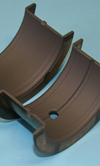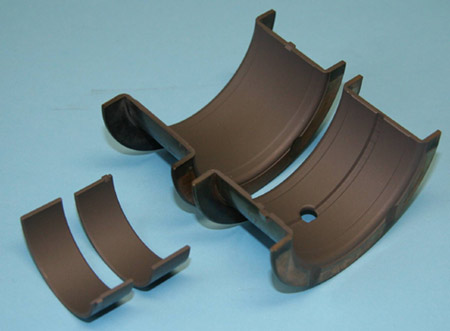Bearing coatings
 The preponderance of multi-cylinder four-stroke race engines means that the production and supply of bearing shells is big business. The share of the bearing market occupied by two-stroke and four-stroke engines with assembled crankshafts that use rolling-element main and crankpin bearings, or four-stroke engines that are designed to use special rolling-element bearings with split outer races, is very small indeed.
The preponderance of multi-cylinder four-stroke race engines means that the production and supply of bearing shells is big business. The share of the bearing market occupied by two-stroke and four-stroke engines with assembled crankshafts that use rolling-element main and crankpin bearings, or four-stroke engines that are designed to use special rolling-element bearings with split outer races, is very small indeed.
The manufacture of bearings, through the application of better manufacturing methods and better material combinations for the bearings and their platings/overlays, is now better than ever. Bearings can withstand higher pressures with better reliability than ever before.
There are a number of companies who supply 'coated' bearings, and who will procure your desired bearing and add their coating before delivering them to you. The claims for these bearings are impressive, but there seems to be little scientific data to back them up. Some companies make more impressive claims than others, but the common claim is that bearing life is increased. Some of the outlandish claims regarding huge power gains or being able to run smaller coolers due to bearing coatings seem implausible. If the lubrication system is working, then the power should be insensitive to changes in the bearing surface material. The fact that some bearing manufacturing companies have now decided to supply coated bearings means they either see the technical benefits or have decided to reap the financial benefits of producing what the customers want.
To try to get to the bottom of this, I spoke to a company that is successfully marketing coated bearings, and also to the representative of a company whose job is the design, manufacture and supply of bespoke bearings for the race business, covering all levels of motorsport.
The coatings applied are said to be 'solid lubricant' or 'dry lubricant' films, and are basically polymer coatings with a low coefficient of friction. They are said to help when lubrication conditions are particularly poor, with engine start-up or oil pump problems being cited as examples. The claim is made that Alan Kulwicki's 1992 NASCAR Cup championship was won due to coated bearings, allowing an engine with an intermittent oil pump problem to finish a race at Martinsville, running several laps after having thrown a pump belt. It is difficult to know if the coating did actually prevent an engine failure.

The make-up of an uncoated bearing should also be able to cope with a temporary loss of oil pressure, although it is obviously desirable if that doesn't happen. The innermost layer of the bearing is a very thin layer of a material with a very low shear stress. This is supported on a much stronger bearing shell. The low shear stress of the overlay means the material can shear when metal-to-metal contact is made, with very little frictional heat being generated. The depth of overlay is important - if it is too thick, it will deform, giving a large contact area and higher friction in conditions of marginal lubrication.
So, we have two approaches to the same problem, one relying on a metallic alloy with low-shear strength to reduce frictional losses and heating in conditions of marginal lubrication, and another using a stronger but low-friction polymer-based coating to achieve the same thing. Once the polymer wears through, however, don't we have the original bearing underneath? Well, probably not as it was intended. By coating a lower shear-strength material, the failure mode of the polymer may not be wear but bulk shear of the layer underneath. If this happens, very little of the original bearing overlay will be left. Pre-coating treatments may also remove some of the original bearing overlay.
There are companies and engine builders who remain adamant that coated bearings are a worthwhile technology, and others who find no improvement and are equally adamant that such coatings offer no gain.
Fig. 1 - Coated bearings are popular, but the debate over the value of coating a bearing is not settled (Picture Courtesy of SwainTech Coatings)
Written by Wayne Ward